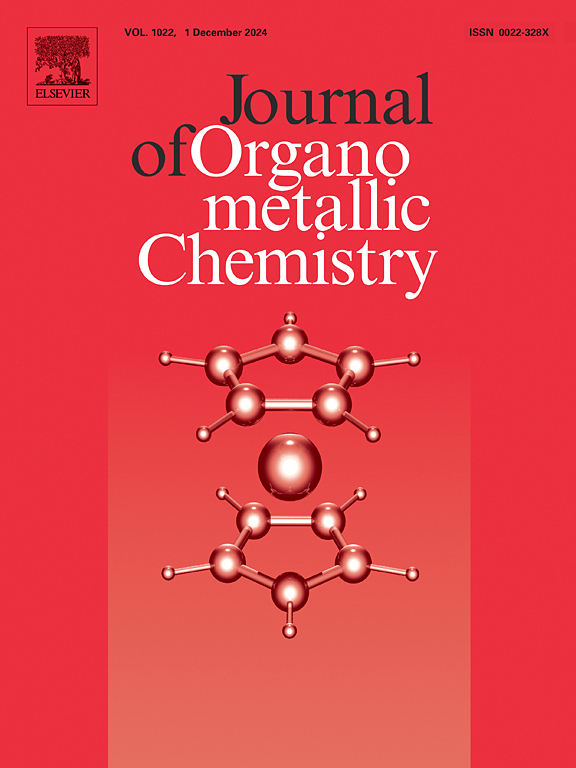Multicomponent synthesis of pyranopyrazoles using a MOF nanocatalyst (Cu(II)@UiO-66-AST) under green conditions
IF 2.1
3区 化学
Q3 CHEMISTRY, INORGANIC & NUCLEAR
引用次数: 0
Abstract
A metal-organic framework (Cu(II)@UiO-66-AST) was used as an acidic nanocatalyst in the four-component reactions of hydrazine, aryl aldehydes, malononitrile, and acetylenic ester that led to pyranopyrazoles. The results clearly show that Cu@UiO-66-AST has a higher catalytic activity than UiO-66-NH2 and Cu(OAc)2. It could be due to the increase of dispersibility of Cu2+ by the formation of several stable complexes between Cu2+ ions and functional groups of ligand Azosulfathiazole (OH, C![]() N, NH, and C-S) on the surface of the nanocatalyst. The advantages of this method include short reaction time (8 min), excellent yield (89–97 %), the use of a green solvent (EtOH), and the use of reusable nanocatalysts. It is noticeable, that the efficiency of Cu(II)@UiO-66-AST didn't show significant change after five consecutive cycles. Also, an evaluation of green metrics such as the E-factor (≤0.2), and atom economy (82.9–87.1 %), quantitatively prove the environmental friendliness of the method.
N, NH, and C-S) on the surface of the nanocatalyst. The advantages of this method include short reaction time (8 min), excellent yield (89–97 %), the use of a green solvent (EtOH), and the use of reusable nanocatalysts. It is noticeable, that the efficiency of Cu(II)@UiO-66-AST didn't show significant change after five consecutive cycles. Also, an evaluation of green metrics such as the E-factor (≤0.2), and atom economy (82.9–87.1 %), quantitatively prove the environmental friendliness of the method.

绿色条件下MOF纳米催化剂Cu(II)@UiO-66-AST多组分合成吡喃吡唑
以金属有机骨架(Cu(II)@UiO-66-AST)为酸性纳米催化剂,研究了肼、芳醛、丙二腈和乙酯四组分合成吡喃吡唑的反应。结果表明,Cu@UiO-66-AST具有比UiO-66-NH2和Cu(OAc)2更高的催化活性。这可能是由于Cu2+离子与配体偶氮磺胺噻唑(OH, CN, NH和C-S)的官能团在纳米催化剂表面形成了几种稳定的配合物,从而增加了Cu2+的分散性。该方法的优点是反应时间短(8 min),收率高(89-97 %),使用绿色溶剂(EtOH),使用可重复使用的纳米催化剂。值得注意的是,Cu(II)@UiO-66-AST的效率在连续5次循环后没有明显变化。此外,对e因子(≤0.2)和原子经济性(82.9-87.1 %)等绿色指标的评价定量地证明了该方法的环境友好性。
本文章由计算机程序翻译,如有差异,请以英文原文为准。
求助全文
约1分钟内获得全文
求助全文
来源期刊

Journal of Organometallic Chemistry
化学-无机化学与核化学
CiteScore
4.40
自引率
8.70%
发文量
221
审稿时长
36 days
期刊介绍:
The Journal of Organometallic Chemistry targets original papers dealing with theoretical aspects, structural chemistry, synthesis, physical and chemical properties (including reaction mechanisms), and practical applications of organometallic compounds.
Organometallic compounds are defined as compounds that contain metal - carbon bonds. The term metal includes all alkali and alkaline earth metals, all transition metals and the lanthanides and actinides in the Periodic Table. Metalloids including the elements in Group 13 and the heavier members of the Groups 14 - 16 are also included. The term chemistry includes syntheses, characterizations and reaction chemistry of all such compounds. Research reports based on use of organometallic complexes in bioorganometallic chemistry, medicine, material sciences, homogeneous catalysis and energy conversion are also welcome.
The scope of the journal has been enlarged to encompass important research on organometallic complexes in bioorganometallic chemistry and material sciences, and of heavier main group elements in organometallic chemistry. The journal also publishes review articles, short communications and notes.
 求助内容:
求助内容: 应助结果提醒方式:
应助结果提醒方式:


